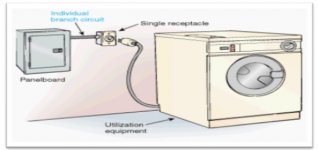In the picture the branch circuit wiring ends at the receptacle and the appliance wiring begins with the cord cap.
Now put a flexible metal conduit whip in place of the cord - the branch circuit wiring ends at the appliance supply terminals and the appliance wiring begins at the same terminal block. The way it has been for a long time, why is it hard to understand?
210.8 A and B require GFCI protection for receptacles meeting conditions/locations mentioned, and always has been that way though go back to 2014 and prior only 15 and 20 amp 120 volt receptacles were mentioned. 2017 they started to add other voltages and other current ratings but was and still is only receptacle outlets mentioned in A and B.
Other parts of 210.8 as well as other articles that bring up GFCI protection have more specifics to them. 210.8(F) just happens to be all outdoor "outlets" at dwelling locations with only exception involving lighting outlets and now the HVAC equipment -- with an expiration date on the exception though, meaning they still intend that HVAC equipment to be protected (whether we think is right or wrong) just giving manufacturers time to develop certain equipment that will play better with GFCI's.



